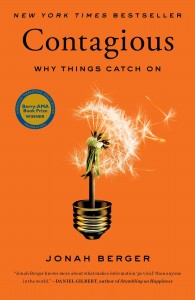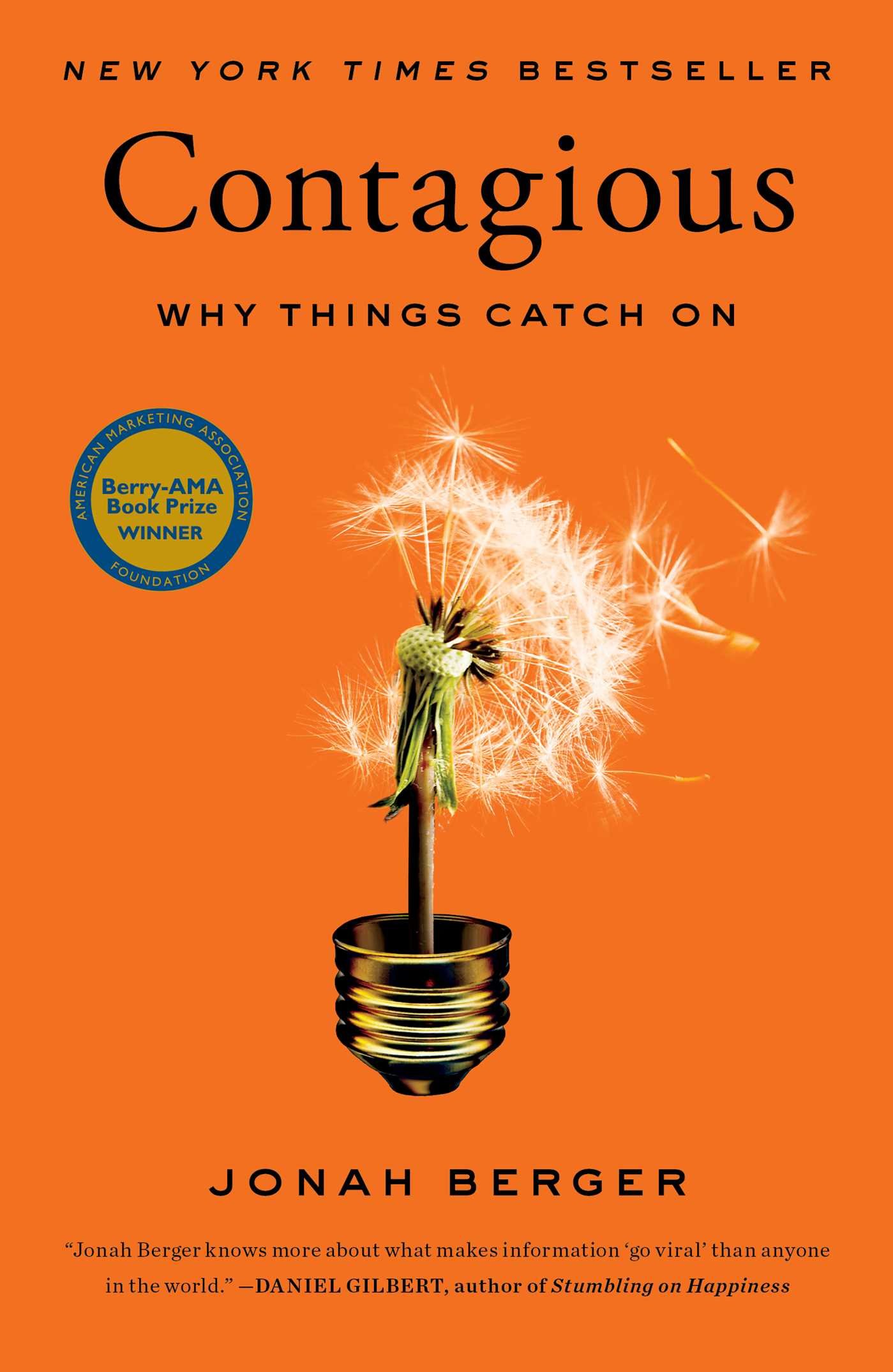 I’ve noticed something. Many of the major books that have changed my life and improved my skills weren’t chosen by me.
I’ve noticed something. Many of the major books that have changed my life and improved my skills weren’t chosen by me.
They were given as gifts, suggested by friends, or discovered randomly.
I’m one of those types that is very systematic in the way I read books, because I’m trying to learn different things, but allowing for some serendipity is a good thing.
My mother sent me this book, because she knows that I’m always hungry to learn new things about marketing.
In this post, I’m going to share what I’ve learned from the book Contagious by Jonah Berger, but before I do that, let’s discuss why you should or shouldn’t buy this book.
You should buy this book if you want to:
- Learn more about marketing in a social media driven world
- Nail down exactly why things go viral online
- Grow traffic to your blog or youtube channel
- Sell digital or physical products online
- Understand how the world works and how things catch on
- Get better at social media marketing and storytelling
You shouldn’t buy this book if:
- You’re already an expert at online marketing
- You’re already familiar with viral marketing and sharing
- You don’t have control of marketing at your company. I guess if even if you can’t implement some of these strategies, you’ll sound smarter in meetings.
So go check it out! Let’s talk about some of the things I’ve learned.
General reasons why things catch on
- It could be simply better
- More attractive pricing
- There is more awareness about it than other products
Organic reasons why things catch on
- Word of mouth. “We’re not going to tell a friend who doesn’t have kids about the best way to change a diaper. Word of mouth tends to reach people who are actually interested in the thing being discussed.”
- Study why people talk, what they talk about, and why some things are talked about more than others.
- Maybe ask yourself “What will people say about me/my product or how will it be described when I’m not in the room.”
- The message matters more than the messenger (influencer). It should spread regardless of who is talking about it.
- Don’t mistake correlation with causation. There are many cute cat videos without millions of views.
- You can make anything talked about, even if it’s boring, but it has to hit the same certain core human emotions.
- Social currency. How does sharing this thing make someone look? Appeal to ego, status, etc.
- Triggers. What reminds someone to talk about it? It could be your environment or cues.
- Emotion. “Naturally contagious content evokes some sort of emotion.” You must make people feel something. Focus on feeling, not function.
- Public. “Monkey see, monkey do.” Make things more open and visible.
- Practical value. The message or product is useful. People like to help their friends.
- Stories. People tell stories. Stories “are vessels that carry things such as morals and lessons. Information travels under the guise of what seems like idle chatter.” Your key message must be a crucial part of telling the story, or will be left out if re-told.
Things I underlined and notes
- “People share things that make them look good to others.”
- “Sharing personal opinions activated the same brain circuits that respond to rewards like food and money.”
- “What people talk about also affects what others think of them [along with what they wear].” Most people talk about interesting stuff to seem interesting.
- “To get people talking, companies need to mind social currency. Give people a way to make themselves look good.”
- “When we talk to others, we’re not only communicating information, we’re also saying something about ourselves.”
- How will your story hold up if it’s told again and again like the game telephone.
- More remarkable products are talked about more, or at least those perceived as remarkable.
- “The key to finding inner remarkability is to think about what makes something interesting, surprising, or novel.”
- The goal is to build buzz or conversations. Why will people talk about it?
- “People don’t just care about how they are doing, they care about their performance in relation to others.” – Using game mechanics.
- “What good is status if no one else knows you have it?”
- How can you make someone feel like they are an insider and convey urgency?
- “Both used scarcity and exclusivity to make customers feel like insiders.”
- How do you make someone feel like they have to have it now?
- “People don’t need to be paid to be motivated.”
- Ongoing word of mouth vs immediate word of mouth. Interesting products = immediate. Doesn’t mean ongoing.
- “Triggers are like little environmental reminders for related concepts on ideas. Accessible thoughts and ideas lead to action.” (like friday/rebecca black)
- “triggers not only get people talking, they keep them talking. Think about whether the message will be triggered by the everyday environment of the target audience.”
- More frequent triggers = better, but should be unique triggers and not trigger other things. What is the mindshare of a trigger?
- For something to be viral, a “large number of people had to make the same decision you did.”
- Evoke an emotion, like awe. We want others to experience the same emotion we had to form a connection.
- “Even if we’re not in the same place, the fact that we both feel the same way bonds us together.”
- Positive things are shared more than negative things.
- “When aroused we do things…arousal kindles the fire.” Like walking around, wringing hands, etc.
- Invoke an emotion that causes arousal, which causes action, not an emotion that stifles action and decreases arousal.
- High arousal positive: awe, excitement, humor. High negative: anger, fear. Low arousal positive: contentment. Low negative: sadness. This is why exercise gets you in a state to take action I think.
- High arousal leads to sharing information and taking action.
- “The best results don’t show up in a search engine, they show up in people’s lives.”
- “Making something more observable makes it easier to imitate. Thus a key factor in driving products to catch on is public visibility.”
- Social proof is powerful. “They probably know something we don’t.”We rely on the intelligence of others.
- “Taking what was once an unobservable thought or behavior and transforming it into a more observable one.”
- Outward things provide an insight into who people are. How do people want to seem like they are?
- “Rather than making the private public, preventing a behavior requires the opposite: making the public private. Making others’ behavior less observable.”
- “People don’t evaluate things in absolute terms. They evaluate them relative to a comparison standard.” (pricing when deciding between products). Why infomercials make it seem like a deal.
- “The same change has a smaller impact the farther it is from the reference point” Ex. winning 20 vs 10 is good. 110 vs 100 is not.
- “Quantity purchase limits increase sales by more than 50 percent.”
- If a price is less than 100, use percentage discounts, for larger, use dollar discounts.
- Stories make the same message have a bigger impact. People treat stories different than information.
- “You start down a path and you want to know how it ends. Until it does, they’ve captured your attention.”
- Stories are vessels for information and learning.
- Stories shape how we perceive culture to be or cultural norms.
- “Information travels under the guise of what seems like idle chatter.”
- “They provide a sort of psychological cover that allows people to talk about a product or idea without seeming like an advertisement.”
- Your product must be “woven so deeply into the narrative that people can’t tell the story without mentioning it.”
Closing thoughts
The one thing that I kept thinking as I read this book is that people need to start creating advertisements to affect their own behavior.
What I mean by that is that we can implement some of these principles to affect our own habits, thoughts, and actions in our life, as well as influencing others.
The other major thing that I took away is that everything is about focusing on feelings. I’m very logic-driven, so that has always been foreign to me, but it’s 100% true.
Finally, the last thing I took away is that feelings drive action, not thoughts. Thoughts might drive feelings which drive action, but ultimately it’s the underlying feelings that cause action.
I highly recommend checking out this book. What I’ve underlined is just a fraction of the gold mine of information!
